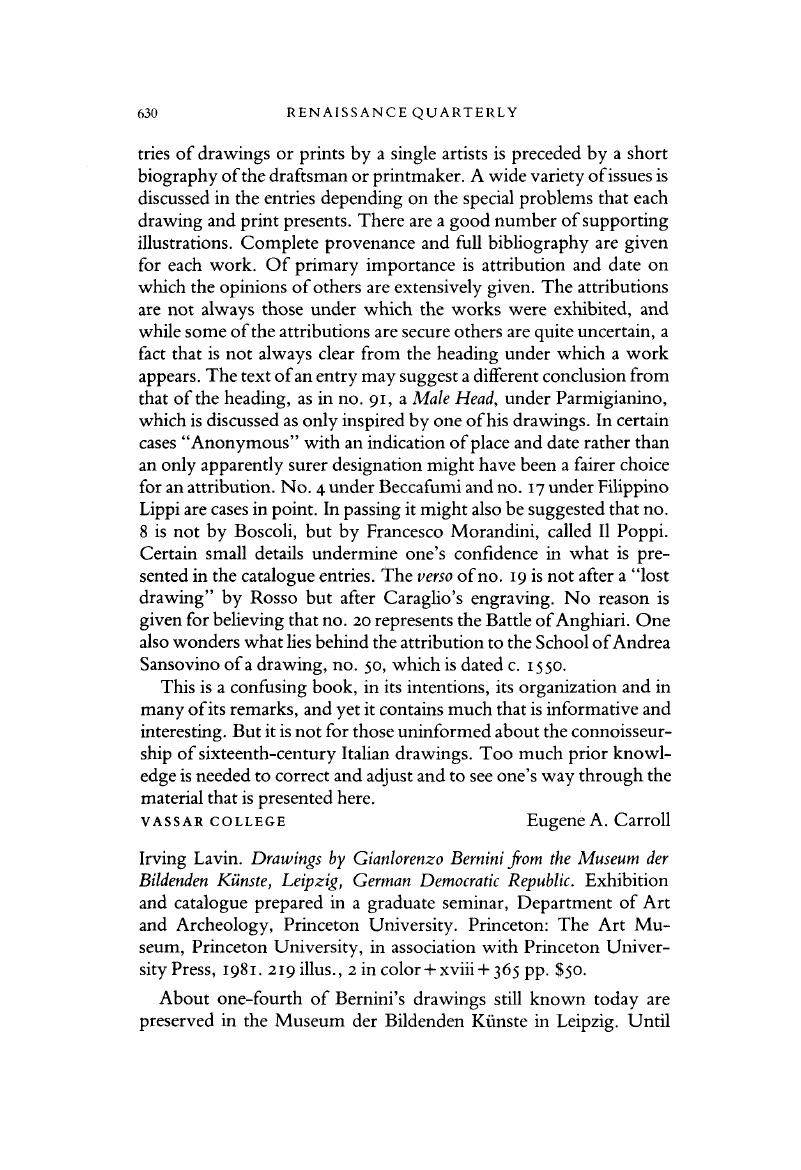No CrossRef data available.
Article contents
Irving Lavin. Drawings by Gianlorenzo Bernini from the Museum der Bildenden Künste, Leipzig, German Democratic Republic. Exhibition and catalogue prepared in a graduate seminar, Department of Art and Archeology, Princeton University. Princeton: The Art Museum, Princeton University, in association with Princeton University Press, 1981. 219 illus., 2 in color + xviii + 365 pp. $50.
Published online by Cambridge University Press: 20 November 2018
Abstract

- Type
- Reviews
- Information
- Copyright
- Copyright © Renaissance Society of America 1982
References
1 Lavin quotes three early references to Bernini's caricatures. The earliest is a letter by Bernini himself (1652) accompanying two such caricatures which he sent to a friend. He avers never to have had greater satisfaction making such caricatures than when he made these two (now lost): “ … mai mi sono più sodisfatto che in queste due caricature e lo fatte di cuore.” The two others are by Baldinucci (1682), who describes the nature of these caricatures, which, as he ends by saying, were often of great princes who shared in the joke and showed them to others of equal rank; and by Domenico Bernini, the artist's son (1713), who also emphasizes that Bernini particularly delighted in making caricatures ‘Teffigie de’ Principi, e Personaggi grandi” who were amused when they recognized themselves or others. Both of these statements were preceded by a passage in Chantelou's Journal (1665) which Lavin did not mention but which seems to me of considerable interest. It is in the entry of August 19 which mentions a visit of Louis XIV to Bernini's work place where the artist was busy with the portrait bust of the king. When a courtier approached the king to talk privately to him, Bernini said “en riant” (but perhaps with some asperity) that he was tempted to make “le portrait charge” of some of these people who interfered with his observation of the model. Chantelou then explained to the king that such “portraits chargés” “étaient des portraits que Ton faisait ressembler dans le laid et le ridicule. L'ébbe Butti a pris la parole et a dit que le Cavalier était admirable dans ces sortes de portraits, qu'il faudrait à faire voir quelqu'un à Sa Majestè et comme Ton a parlé de quelqu'un de femme, le Cavalier a dit que Non bisognara caricar le donne die da notte.” This passage makes perfectly clear that caricatures, or “portraits charges,” were an established art form (even though still unfamiliar to Louis XIV) and that Bernini had a special reputation for making them—but Chantelou would hardly have failed to stress Bernini's role as the inventor of the genre if he had, in fact, been that.
2 One admittedly marginal point made by Professor Lavin in his reference to a humorous sketch in one of Dürer's letters to Pirckheimer (pp. 30-31) is in my view completely untenable, even though he supports his view with a reference to Lange-Fuhse's 1893 edition of Dürer's literary remains. This untidy head, a “Fratze,” as the Germans would call it, appears between two completely different passages of text. Lavin argues that it belongs to the succeeding sentence in which Diirer reports with pride of the success of his altar of the Rosenkranz Madonna (now in Prague); and that the scurrilous head he sketched before that passage expresses a sardonic thought about the Venetian art critics (who before had questioned his ability to handle color) somewhat like this (these are Professor Lavin's words): “Here is my Madonna, reduced to the form these fools can appreciate.” I think such an interpretation is erroneous on more than one ground. It first fails to even consider the preceding sentence, which is a coarsely humorous reference to a meeting place of his Nuremberg friends where (as Rupprich judges from the context) a lewd joke had been made about the absent artist; he now sends his answer in the same way, jokingly reporting that he had ordered ten hundredweights of wood from the olive tree to cleanse the “Stube” of its stench. The grotesque drawing follows immediately after the last word of this sentence, forcing Dürer to write the lines of the next sentence (about the Rosenkranz Madonna) around this head which occupies the space of about four lines. How could Pirckheimer, reading the letter, have possibly understood the meaning of that child-like Fratze in the sense Professor Lavin imputes to it, before he had even read the passage to which it supposedly refers? In another letter Diirer also made a few humorous sketches (February 7, 1506) which clearly follow the text to which they belong. We do not know what kind of joke it was that prompted Dürer to end his answer with the grotesque scrawl of a head, though knowing his often pretty outspoken manner, it would not be too difficult to fit words to it as a further commentary on the “stinking” Herrenstube in Nuremberg. But the ironically convoluted manner in which Professor Lavin “deciphers” the message of the jocular face is not only unlikely per se, but in my opinion irreconcilable with Dürer's very direct way of speaking his mind.




